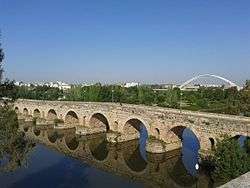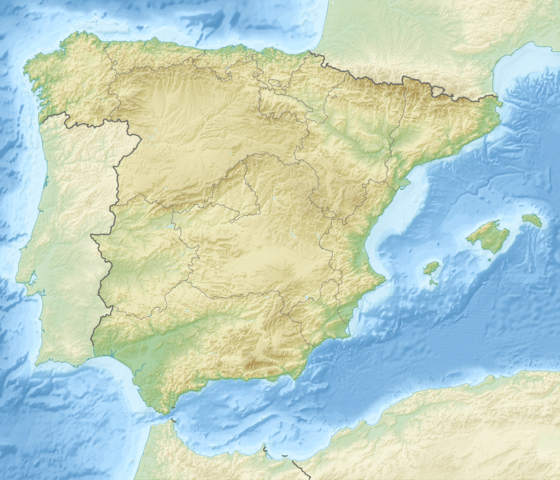Puente Romano, Mérida
| Puente Romano | |
|---|---|
 Puente Romano as seen from Alcazaba of Mérida | |
| Coordinates | 38°54′47″N 6°21′03″W / 38.91306°N 6.35083°WCoordinates: 38°54′47″N 6°21′03″W / 38.91306°N 6.35083°W |
| Crosses | Guadiana River |
| Locale | Mérida, Spain |
| Characteristics | |
| Design | Arch bridge |
| Material | Granite ashlar |
| Total length | 790 m (incl. approaches) |
| Width | Ca. 7.1 m |
| Longest span | 11.6 m |
| No. of spans | 60 (incl. 3 buried) |
| History | |
| Construction end | Reign of Trajan (98–117 AD) |
 Puente Romano Location in Spain | |
The Puente Romano (Spanish for Roman Bridge) is a Roman bridge over the Guadiana River at Mérida, Spain. It is the world's longest (in terms of distance) surviving bridge from ancient times, having once featured an estimated overall length of 755 m with 62 spans.[1] Today, there are 60 spans (three of which are buried on the southern bank) on a length of 721 m between the abutments. Including the approaches, the structure totals 790 m. It is still in use, but was pedestrianized in 1991 as road traffic was redirected to use the nearby Lusitania Bridge.
Annexed to the bridge is the Alcazaba of Mérida, a Moorish fortification built in 835.
Close to the remains of the Acueducto de los Milagros, there exists another Roman bridge at Mérida, the much smaller Puente de Albarregas.
See also
Notes
- ↑ O’Connor 1993, pp. 106–107
Sources
- O’Connor, Colin (1993), Roman Bridges, Cambridge University Press, pp. 106f. (SP15), ISBN 0-521-39326-4
External links
![]()
- Puente Romano (Mérida) at Structurae
- Traianus – Technical investigation of Roman public works